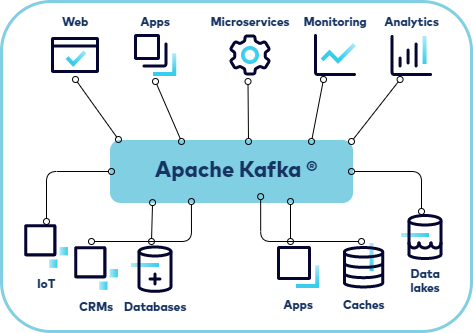🚀 Apache Kafka Demystified: Features, Jargon, Setup & Pro Tips for 2025 💡
🚀 Apache Kafka Demystified: Features, Jargon, Setup & Pro Tips for 2025 💡
If data is the new oil, Apache Kafka is the pipeline that delivers it — fast, reliable, and at scale. Whether you’re building real-time analytics, event-driven microservices, or stream processing pipelines, Kafka has become the go-to choice. And with Kafka 4.0 (2025), ZooKeeper is officially gone — welcome to the KRaft era! ⚡
Let’s explore features, terminologies, setup, and pro tips step-by-step.

🌟 What is Apache Kafka?
Apache Kafka is a distributed event streaming platform that allows you to publish, subscribe, store, and process records (messages) in real-time.
Think of it like:
📮 Post Office for your data → Producers send letters (events), Kafka stores them in mailboxes (topics), and consumers pick them up.
🏆 Key Features of Kafka
- High Throughput 🚀 — Can handle millions of messages per second.
- Low Latency ⚡ — Near real-time delivery.
- Scalable Horizontally 📈 — Add brokers to increase capacity.
- Fault-Tolerance 🛡️ — Data is replicated across brokers.
- Durability 💾 — Data stored on disk for long-term reliability.
- Decoupled Architecture 🔗 — Producers and consumers don’t need to know each other.
- Exactly-Once Semantics ✅ — Guaranteed non-duplicate processing with idempotent producers.
- KRaft Mode (ZooKeeper-free) 🆕 — Simplified deployment and management in Kafka 4.0.
📚 Kafka Terminologies You Must Know
- Broker 🏢 — A Kafka server that stores and serves messages.
- Topic 📂 — A category for storing messages (like a channel).
- Partition 🔀 — Splitting topics into smaller chunks for scalability.
- Offset 📌 — A unique ID for each message in a partition.
- Producer ✉️ — Sends data to Kafka topics.
- Consumer 📥 — Reads data from Kafka topics.
- Consumer Group 👥 — Multiple consumers sharing the load.
- Replication Factor 🔁 — Copies of data stored for fault tolerance.
- Retention Period ⏳ — How long Kafka keeps data.
💼 Real-World Use Cases
- 📊 Real-Time Analytics — e.g., Uber tracking rides live.
- 🏦 Bank Transactions — Fraud detection in real-time.
- 🛒 E-commerce — Tracking user activity for recommendations.
- 📡 IoT Data Streaming — Collecting sensor data from devices.
- 📰 Log Aggregation — Centralizing logs for monitoring.
⚙️ Step-by-Step Kafka Setup (Docker + KRaft Mode)
Here’s how to spin up Kafka locally without ZooKeeper.
1️⃣ Create a docker-compose.yml
version: '3.8'
services:
kafka:
image: bitnami/kafka:latest
container_name: kafka
ports:
- "9092:9092"
environment:
- KAFKA_CFG_NODE_ID=1
- KAFKA_CFG_PROCESS_ROLES=broker,controller
- KAFKA_CFG_CONTROLLER_LISTENER_NAMES=CONTROLLER
- KAFKA_CFG_LISTENERS=PLAINTEXT://:9092,CONTROLLER://:9093
- KAFKA_CFG_ADVERTISED_LISTENERS=PLAINTEXT://localhost:9092
- KAFKA_CFG_CONTROLLER_QUORUM_VOTERS=1@localhost:9093
- ALLOW_PLAINTEXT_LISTENER=yes2️⃣ Start Kafka
docker-compose up -d3️⃣ Create a Topic
docker exec kafka kafka-topics.sh --create \
--topic my-topic \
--bootstrap-server localhost:9092 \
--partitions 3 --replication-factor 14️⃣ Produce a Message
docker exec -it kafka kafka-console-producer.sh \
--topic my-topic --bootstrap-server localhost:9092
> Hello Kafka! 🚀5️⃣ Consume a Message
docker exec -it kafka kafka-console-consumer.sh \
--topic my-topic --from-beginning \
--bootstrap-server localhost:9092💡 Bonus Pro Tips for Mastering Kafka
- Plan Partitions Wisely — Too few = bottlenecks, too many = overhead.
- Use Idempotent Producers — Avoid duplicate messages.
- Enable Compression — (
snappyorlz4) to save bandwidth. - Set Proper Retention — Avoid storage overload.
- Secure Your Kafka — Use SASL_SSL for authentication & encryption.
- Monitor with Tools — Like Confluent Control Center or Prometheus + Grafana.
- Leverage Kafka Streams / ksqlDB — For real-time data processing without extra frameworks.
🏁 Wrapping Up
Kafka is not just a messaging system — it’s a high-performance backbone for modern data-driven applications.
With Kafka 4.0’s KRaft mode, setup and scaling have never been easier.
💬 Your Turn — Have you tried running Kafka in KRaft mode yet?
Drop your experiences below! ⬇️
Comments
Post a Comment